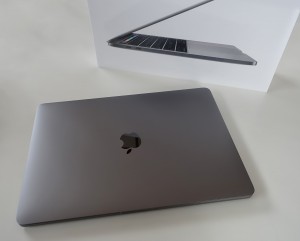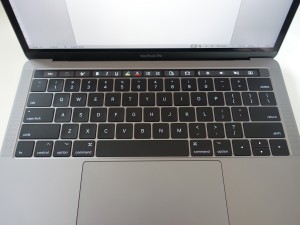
My personal Macbook Pro is 4.5 years old. It still runs pretty well and I personally have no major issue with it. However, it does feel a lot heavier than my 10.5″ iPad Pro, or even Macbook 12″ 2015 that I used for work. For those who says that laptop weight does not matter, when someday you decide to actually get a lightweight laptop and carry it around on a regular basis, you will understand.
Having said that, the real trigger of my upgrade was the day I saw a really good online deal on the new 2017 model of Macbook Pro with Touch Bar and Touch ID. It was a store offering direct import from Hong Kong, which is known as the cheapest place to get Apple products outside the US. To make the deal even sweeter, further 20% discount was offered. In total, the price was around $800 cheaper from Australian price for the same model.
 The perfect laptop size for me is always around 12″ to 13″, hence I never got myself a 15″ laptop of any brand. I do the same with this Macbook Pro. I got myself a 13″ model with Touch Bar and Touch ID. When I first read about them, these new features were indeed interesting. However, it was not compelling enough for me to drop the big money. Getting it on over $800 saving is another story.
The perfect laptop size for me is always around 12″ to 13″, hence I never got myself a 15″ laptop of any brand. I do the same with this Macbook Pro. I got myself a 13″ model with Touch Bar and Touch ID. When I first read about them, these new features were indeed interesting. However, it was not compelling enough for me to drop the big money. Getting it on over $800 saving is another story.
First, let’s start with dimensions. This Macbook is only 14.9 mm thick and the weight is 1.37 kg. Admittedly it’s still slightly heavier than 0.92 kg 12″ Macbook, but it’s far better than my old 2013 Macbook Pro that weighs 1.62 kg.
The model I got has 3.1 GHz Intel Core i5 processor, 8 GB 2133 MHz LPDDR3 RAM, Intel Iris Plus Graphics 650 1536 MB, 512 GB internal SSD, 13.3-inch display with 2560 x 1600 retina resolution and 500 nits brightness, Touch Bar, built-in fingerprint sensor for Touch ID, 4 USB type-C ports with USB 3.1 Gen 2 and Thunderbolt 3 support, stereo speakers, 3.5 mm headphone jack, 3 built-in microphones, 720p FaceTime HD camera, full-sized backlit keyboard, Force Touch trackpad, 802.11ac Wi-Fi and Bluetooth 4.2. The internal SSD storage is rated to perform up to 3.2GB/s sequential read speed and up to 2.2GB/s sequential write speed.
If you purchase this model now, it will come with macOS High Sierra pre-installed. My model is apparently produced before the release date of High Sierra, so it comes with macOS Sierra instead. Not a big deal because I could easily upgrade.
 Since I have used 2015 Macbook 12″ with USB-C port for a while, the transition to a laptop without “normal” USB port is no longer a problem for me. I already have USB flash drive with dual connectors (USB and USB-C) and I already have the necessary connectors and/or USB hubs. Having 4 USB-C ports instead of 1 is really a big deal. I don’t have to worry about the need to charge my Macbook while accessing some USB device anymore. Apple should’ve given the 12″ Macbook at least 2 USB-C ports.
Since I have used 2015 Macbook 12″ with USB-C port for a while, the transition to a laptop without “normal” USB port is no longer a problem for me. I already have USB flash drive with dual connectors (USB and USB-C) and I already have the necessary connectors and/or USB hubs. Having 4 USB-C ports instead of 1 is really a big deal. I don’t have to worry about the need to charge my Macbook while accessing some USB device anymore. Apple should’ve given the 12″ Macbook at least 2 USB-C ports.
Being a Macbook, I get the incredibly well-built machine that I expected from the brand. As usual, it’s stable and reliable. The cooling system works quite well. In my normal usage, it only gets slightly warm, never to the point of worryingly hot. Battery life is also not an issue. Apple promises 10 hours for a single full charge. I haven’t really timed it, but it nicely survive whole day of work (around 7 hours) with good 30% of power remaining.
Touch ID in my laptop takes a while to get used to. After few days of using this new machine, I still type my login password subconsciously every time I need to start using it, forgetting that I could just easily use my fingerprint to unlock.
Touch Bar is a nice little feature that could be amazingly useful or wastefully useless. To start with, not all apps support this niche. When we use an app with Touch Bar support, it does give us some very useful shortcut that could potentially allow us faster work and better productivity. That is, if we actually remember to look at it and use it. In my case, I still often forget that it’s even there. Microsoft Office is a good example of popular app with full Touch Bar support. Working with Word or Excel feels different with Touch Bar. For Internet browsing, Safari and Chrome offer very different sets of TouchBar shortcuts. In Safari, we even get different Touch Bar shortcuts depending on the location of our active focus. Too bad that Firefox hasn’t offered TouchBar support yet, hopefully soon. Chatting in iMessage and choosing our emoji in TouchBar feels very iPad-like. Even opening Calculator app shows nice little shortcuts on the TouchBar.
When we use an app without Touch Bar support, it only shows the default 4 icons on the right side plus the esc icon on the left. Some users might got confused because they no longer see the usual F1-F12 buttons. Sure we can press the Fn button and Touch Bar will display F1 to F12 virtual buttons, but this adds extra step and could be annoying if an app relies heavily on F button as shortcuts.
Just for its thinner and lighter physical form, this is already a nice upgrade. Newer generation processor and 512 GB SSD make most things run impressively smooth. Touch Bar and Touch ID are nice additions. Hopefully more apps will add Touch Bar support in the future. Welcome, my new productivity machine.

Leave A Comment